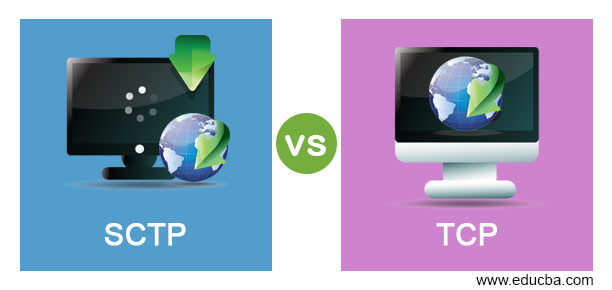Updated April 5, 2023

Difference Between SCTP vs TCP
The following article provides an outline for SCTP vs TCP. SCTP is a link-oriented protocol in computer networks that allows for full-duplex transmission of multiple streams of data between two endpoints, creating a network connection.
TCP is a connection-oriented protocol that ensures data transmission. TCP ensures secure data transfer right from the start of the connection. It is a transport layer protocol that allows packets to be sent from one location to another. It’s a link-oriented protocol, which means it defines the connection before the contact between the network’s computing devices. This interface is used for an IP protocol, but they are referred to as a TCP/IP.
The TCP’s primary role is to collect data from the application layer. It then splits the data into multiple packets, assigns a number to each packet, and sends the packets to their destination. TCP, on the other hand, reassembles the packets before sending them to the device layer.
Head to Head Comparison Between SCTP vs TCP (Infographics)
Below are the top differences between SCTP vs TCP
Key Difference between SCTP vs TCP
Let us discuss some of the major key differences between SCTP vs TCP
- Multi-homing is the first functionality that SCTP introduces to the mix. Multi-homing requires a connection’s two endpoints to declare multiple interfaces (IP addresses). Providing a backup path for data in the event that the existing interface fails for whatever reason. The communication is not disrupted, and the transition from one interface to another is smooth. TCP does not support Multihoming.
- SCTP supports Multi-streaming, whereas TCP does not provide Multi-streaming. Instead of using a single data source, SCTP can create different sources that can be used separately. This doesn’t actually increase the medium’s speed, but it does allow data to arrive in parallel, reducing the time it takes for pages to fully load. This feature also prevents control packets from being blocked by data packets, which is something that happens frequently.
- TCP is vulnerable to Denial of service attacks that lock up the server’s resources and block others from accessing it, which are very vulnerable. SCTP uses a 4-way handshake that allocates money at the end of the handshake, rather than the 3-way handshake used for TCP. SCTP is not vulnerable to DoS attacks as a result of this.
- Data in TCP arrives in packets. Packets are of a certain size, so a long stream will be divided to match, while short streams would be spliced together. To completely distinguish different messages, message framing must be supported at the application layer. SCTP uses message framing, which ensures that each message is the same size as it is sent out as it was when it was received.
- SCTP has made ordering delivery an option. In certain cases, ordering delivery is needed. That is why it is required in TCP. However, in some situations where ordering isn’t needed, disabling this feature will free up resources. With optional ordered delivery, SCTP provides flexibility to satisfy each condition.
- SCTP has unordered data delivery. Whereas There is no unordered data delivery in TCP.
- The transmission type of SCTP is news-oriented. On the other hand, the Transmission type of TCP is byte-oriented.
- Error tolerance is available in SCTP. TCP does not have an Error tolerance.
- SCTP has Preservation of message boundaries whereas in TCP preservation of message boundaries.
- SCTP provides Protection against SYN flooding attacks. On the other hand, TCP does not provide Protection against SYN flooding attacks.
- SCTP does not allow half-closed connections, whereas TCP allows half-closed connections.
- SCTP does not have Pseudo-header for checksum. TCP has Pseudo-header for checksum
Comparison table of SCTP vs TCP
The following table demonstrates the detailed comparison between the SCTP vs TCP
| Sr. No. | SCTP | TCP |
| 1 | It supports multi-streaming. | It doesn’t support multi-streaming. |
| 2 | there are selective ACKs in SCTP. | Selective ACKs are optional in TCP. |
| 3 | SCTP supports Multihoming. | TCP does not support Multihoming. |
| 4 | SCTP provides more reliable data transfer | There is less reliable data transfer in TCP. |
| 5 | SCTP provides more secure data transfer than TCP. | TCP data transfer is less secure. |
| 6 | SCTP has partial data transfer in this. | There is no partial data transfer in this. |
| 7 | SCTP has unordered data delivery. | There is no unordered data delivery in TCP. |
| 8 | The transmission type of SCTP is news-oriented. | The transmission type of TCP is stream-oriented. |
| 9 | SCTP has Error tolerance | TCP has Error tolerance |
| 10 | SCTP supports the Preservation of message boundaries | It does not support the Preservation of message boundaries |
| 11 | It provides protection against SYN flooding attacks | It does not provide Protection against SYN flooding attacks |
| 12 | It does not allow half-closed connections | It allows half-closed connections |
| 13 | There is no Pseudo-header for checksum. | It has Pseudo-header for checksum. |
Conclusion
In this article, we have seen key differences between SCTP and TCP. SCTP is equivalent to TCP in several respects. However, transitioning to the superior one is difficult due to our long-term use of TCP. Nonetheless, SCTP’s benefits will eventually attract interest and users. I hope you will find this article helpful.
Recommended Articles
This is a guide to SCTP vs TCP. Here we discuss the SCTP vs TCP key differences with infographics and comparison table. You may also have a look at the following articles to learn more –

